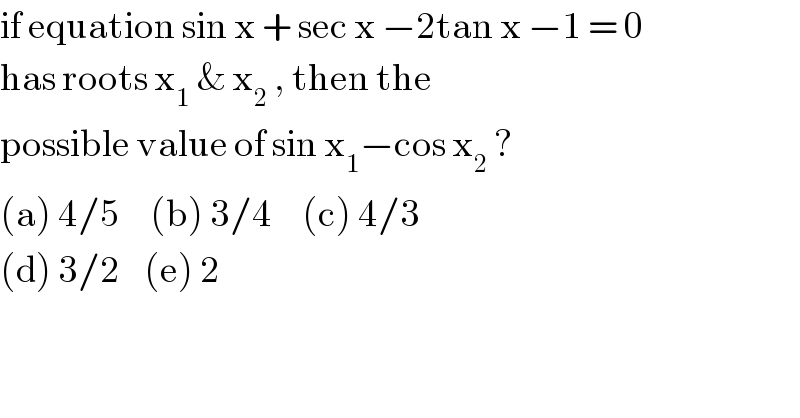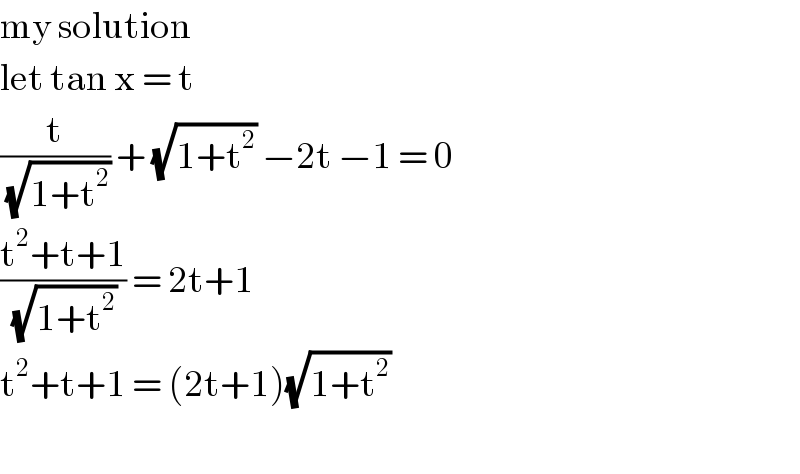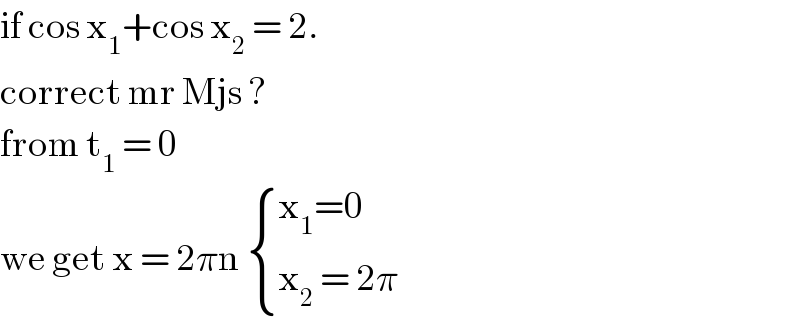
Question Number 87419 by john santu last updated on 04/Apr/20

$$\mathrm{if}\:\mathrm{equation}\:\mathrm{sin}\:\mathrm{x}\:+\:\mathrm{sec}\:\mathrm{x}\:−\mathrm{2tan}\:\mathrm{x}\:−\mathrm{1}\:=\:\mathrm{0} \\ $$ $$\mathrm{has}\:\mathrm{roots}\:\mathrm{x}_{\mathrm{1}} \:\&\:\mathrm{x}_{\mathrm{2}} \:,\:\mathrm{then}\:\mathrm{the}\: \\ $$ $$\mathrm{possible}\:\mathrm{value}\:\mathrm{of}\:\mathrm{sin}\:\mathrm{x}_{\mathrm{1}} −\mathrm{cos}\:\mathrm{x}_{\mathrm{2}} \:? \\ $$ $$\left(\mathrm{a}\right)\:\mathrm{4}/\mathrm{5}\:\:\:\:\:\left(\mathrm{b}\right)\:\mathrm{3}/\mathrm{4}\:\:\:\:\:\left(\mathrm{c}\right)\:\mathrm{4}/\mathrm{3}\: \\ $$ $$\left(\mathrm{d}\right)\:\mathrm{3}/\mathrm{2}\:\:\:\:\left(\mathrm{e}\right)\:\mathrm{2} \\ $$
Commented byjohn santu last updated on 04/Apr/20

$$\mathrm{how}\:\mathrm{sir}\:\mathrm{your}\:\mathrm{solution} \\ $$
Commented byMJS last updated on 04/Apr/20

$$\mathrm{none}\:\mathrm{of}\:\mathrm{these} \\ $$ $$\mathrm{for}\:\mathrm{0}\leqslant{x}<\mathrm{2}\pi\:\mathrm{I}\:\mathrm{get}\:{x}=\mathrm{0}\vee{x}\approx\mathrm{2}.\mathrm{44853} \\ $$
Commented byjohn santu last updated on 04/Apr/20

$$\mathrm{my}\:\mathrm{solution}\: \\ $$ $$\mathrm{let}\:\mathrm{tan}\:\mathrm{x}\:=\:\mathrm{t}\: \\ $$ $$\frac{\mathrm{t}}{\sqrt{\mathrm{1}+\mathrm{t}^{\mathrm{2}} }}\:+\:\sqrt{\mathrm{1}+\mathrm{t}^{\mathrm{2}} }\:−\mathrm{2t}\:−\mathrm{1}\:=\:\mathrm{0} \\ $$ $$\frac{\mathrm{t}^{\mathrm{2}} +\mathrm{t}+\mathrm{1}}{\sqrt{\mathrm{1}+\mathrm{t}^{\mathrm{2}} }}\:=\:\mathrm{2t}+\mathrm{1}\: \\ $$ $$\mathrm{t}^{\mathrm{2}} +\mathrm{t}+\mathrm{1}\:=\:\left(\mathrm{2t}+\mathrm{1}\right)\sqrt{\mathrm{1}+\mathrm{t}^{\mathrm{2}} } \\ $$ $$ \\ $$
Commented byjohn santu last updated on 04/Apr/20

$$\mathrm{if}\:\mathrm{cos}\:\mathrm{x}_{\mathrm{1}} +\mathrm{cos}\:\mathrm{x}_{\mathrm{2}} \:=\:\mathrm{2}. \\ $$ $$\mathrm{correct}\:\mathrm{mr}\:\mathrm{Mjs}\:? \\ $$ $$\mathrm{from}\:\mathrm{t}_{\mathrm{1}} \:=\:\mathrm{0} \\ $$ $$\mathrm{we}\:\mathrm{get}\:\mathrm{x}\:=\:\mathrm{2}\pi\mathrm{n}\:\begin{cases}{\mathrm{x}_{\mathrm{1}} =\mathrm{0}}\\{\mathrm{x}_{\mathrm{2}} \:=\:\mathrm{2}\pi}\end{cases} \\ $$
Commented byMJS last updated on 04/Apr/20

$$\mathrm{this}\:\mathrm{is}\:\mathrm{somehow}\:\mathrm{true}\:\mathrm{but}\:\mathrm{the}\:\mathrm{given}\:\mathrm{equation} \\ $$ $$\mathrm{has}\:\mathrm{infinite}\:\mathrm{solutions}\:\mathrm{and}\:\mathrm{it}'\mathrm{s}\:\mathrm{asked}\:\mathrm{for}\:\mathrm{2} \\ $$ $$\mathrm{solutions}\:{x}_{\mathrm{1}} \:\mathrm{and}\:{x}_{\mathrm{2}} .\:\mathrm{I}\:\mathrm{think}\:{x}_{\mathrm{1}} \neq{x}_{\mathrm{2}} \wedge{x}_{\mathrm{1}} \neq{x}_{\mathrm{2}} +\mathrm{2}{n}\pi \\ $$ $$\mathrm{but}\:\mathrm{anyway}\:\mathrm{sin}\:{x}_{\mathrm{1}} \:−\mathrm{cos}\:{x}_{\mathrm{2}} \:\neq\:\mathrm{any}\:\mathrm{of}\:\mathrm{the} \\ $$ $$\mathrm{given}\:\mathrm{options} \\ $$ $$\mathrm{the}\:\mathrm{question}\:\mathrm{is}\:\mathrm{very}\:\mathrm{strange}... \\ $$
Commented byjohn santu last updated on 04/Apr/20

$$\mathrm{yes}\:\mathrm{sir}\:\mathrm{i}\:\mathrm{agree} \\ $$
Answered by MJS last updated on 04/Apr/20

$${t}=\mathrm{tan}\:\frac{{x}}{\mathrm{2}}\:\Leftrightarrow\:{x}=\mathrm{2arctan}\:{t} \\ $$ $$\frac{−\mathrm{2}{t}\left({t}^{\mathrm{3}} −\mathrm{3}{t}^{\mathrm{2}} +{t}−\mathrm{1}\right)}{{t}^{\mathrm{4}} −\mathrm{1}}=\mathrm{0} \\ $$ $${t}_{\mathrm{1}} =\mathrm{0} \\ $$ $${t}^{\mathrm{3}} −\mathrm{3}{t}^{\mathrm{2}} +{t}−\mathrm{1}=\mathrm{0} \\ $$ $${t}={z}+\mathrm{1} \\ $$ $${z}^{\mathrm{3}} −\mathrm{2}{z}−\mathrm{2}=\mathrm{0} \\ $$ $${D}=\frac{\left(−\mathrm{2}\right)^{\mathrm{3}} }{\mathrm{27}}+\frac{\left(−\mathrm{2}\right)^{\mathrm{2}} }{\mathrm{4}}=\frac{\mathrm{19}}{\mathrm{27}}>\mathrm{0}\:\Rightarrow\:\mathrm{Cardano} \\ $$ $${z}=\sqrt[{\mathrm{3}}]{\mathrm{1}+\frac{\sqrt{\mathrm{57}}}{\mathrm{9}}}+\sqrt[{\mathrm{3}}]{\mathrm{1}−\frac{\sqrt{\mathrm{57}}}{\mathrm{9}}} \\ $$ $$\Rightarrow\:{t}_{\mathrm{2}} =\mathrm{1}+\sqrt[{\mathrm{3}}]{\mathrm{1}+\frac{\sqrt{\mathrm{57}}}{\mathrm{9}}}+\sqrt[{\mathrm{3}}]{\mathrm{1}−\frac{\sqrt{\mathrm{57}}}{\mathrm{9}}}\approx\mathrm{2}.\mathrm{76929} \\ $$ $$\Rightarrow \\ $$ $${x}_{\mathrm{1}} =\mathrm{0} \\ $$ $${x}_{\mathrm{2}} =\mathrm{2arctan}\:\left(\mathrm{1}+\sqrt[{\mathrm{3}}]{\mathrm{1}+\frac{\sqrt{\mathrm{57}}}{\mathrm{9}}}+\sqrt[{\mathrm{3}}]{\mathrm{1}−\frac{\sqrt{\mathrm{57}}}{\mathrm{9}}}\right)\:\approx\mathrm{2}.\mathrm{44853} \\ $$
Commented byjohn santu last updated on 04/Apr/20

$$\mathrm{i}'\mathrm{m}\:\mathrm{stuck}\:\mathrm{in}\:\mathrm{Cardano}\:\mathrm{sir} \\ $$
Commented byMJS last updated on 04/Apr/20
![x^3 +ax^2 +bx+c=0 let x=t−(a/3) t^3 −((a^2 −3b)/3)t+((2a^3 −9ab+27c)/(27))=0 −((a^2 −3b)/3)=p∧((2a^3 −9ab+27c)/(27))=q t^3 +pt+q=0 D=(p^3 /(27))+(q^2 /4) { ((>0 ⇒ Cardano)),((<0 ⇒ trigonimetric solution)) :} Cardano u=((−(q/2)+(√((p^3 /(27))+(q^2 /4)))))^(1/3) v=((−(q/2)−(√((p^3 /(27))+(q^2 /4)))))^(1/3) [we need the real roots i.e. ((−1))^(1/3) =−1] t_1 =u+v t_2 =(−(1/2)−((√3)/2)i)u+(−(1/2)+((√3)/2)i)v t_3 =(−(1/2)+((√3)/2)i)u+(−(1/2)−((√3)/2)i)v trigononetric solution t_(j+1) =((2(√(−3p)))/3)sin (((2jπ)/3)−(1/3)arcsin ((3(√3)q)/(2p(√(−p))))) with j=0, 1, 2](Q87450.png)
$${x}^{\mathrm{3}} +{ax}^{\mathrm{2}} +{bx}+{c}=\mathrm{0} \\ $$ $$\mathrm{let}\:{x}={t}−\frac{{a}}{\mathrm{3}} \\ $$ $${t}^{\mathrm{3}} −\frac{{a}^{\mathrm{2}} −\mathrm{3}{b}}{\mathrm{3}}{t}+\frac{\mathrm{2}{a}^{\mathrm{3}} −\mathrm{9}{ab}+\mathrm{27}{c}}{\mathrm{27}}=\mathrm{0} \\ $$ $$−\frac{{a}^{\mathrm{2}} −\mathrm{3}{b}}{\mathrm{3}}={p}\wedge\frac{\mathrm{2}{a}^{\mathrm{3}} −\mathrm{9}{ab}+\mathrm{27}{c}}{\mathrm{27}}={q} \\ $$ $${t}^{\mathrm{3}} +{pt}+{q}=\mathrm{0} \\ $$ $${D}=\frac{{p}^{\mathrm{3}} }{\mathrm{27}}+\frac{{q}^{\mathrm{2}} }{\mathrm{4}}\:\begin{cases}{>\mathrm{0}\:\Rightarrow\:\mathrm{Cardano}}\\{<\mathrm{0}\:\Rightarrow\:\mathrm{trigonimetric}\:\mathrm{solution}}\end{cases} \\ $$ $$ \\ $$ $$\mathrm{Cardano} \\ $$ $${u}=\sqrt[{\mathrm{3}}]{−\frac{{q}}{\mathrm{2}}+\sqrt{\frac{{p}^{\mathrm{3}} }{\mathrm{27}}+\frac{{q}^{\mathrm{2}} }{\mathrm{4}}}}{v}=\sqrt[{\mathrm{3}}]{−\frac{{q}}{\mathrm{2}}−\sqrt{\frac{{p}^{\mathrm{3}} }{\mathrm{27}}+\frac{{q}^{\mathrm{2}} }{\mathrm{4}}}} \\ $$ $$\:\:\:\:\:\left[\mathrm{we}\:\mathrm{need}\:\mathrm{the}\:\mathrm{real}\:\mathrm{roots}\:\mathrm{i}.\mathrm{e}.\:\sqrt[{\mathrm{3}}]{−\mathrm{1}}=−\mathrm{1}\right] \\ $$ $${t}_{\mathrm{1}} ={u}+{v} \\ $$ $${t}_{\mathrm{2}} =\left(−\frac{\mathrm{1}}{\mathrm{2}}−\frac{\sqrt{\mathrm{3}}}{\mathrm{2}}\mathrm{i}\right){u}+\left(−\frac{\mathrm{1}}{\mathrm{2}}+\frac{\sqrt{\mathrm{3}}}{\mathrm{2}}\mathrm{i}\right){v} \\ $$ $${t}_{\mathrm{3}} =\left(−\frac{\mathrm{1}}{\mathrm{2}}+\frac{\sqrt{\mathrm{3}}}{\mathrm{2}}\mathrm{i}\right){u}+\left(−\frac{\mathrm{1}}{\mathrm{2}}−\frac{\sqrt{\mathrm{3}}}{\mathrm{2}}\mathrm{i}\right){v} \\ $$ $$ \\ $$ $$\mathrm{trigononetric}\:\mathrm{solution} \\ $$ $${t}_{{j}+\mathrm{1}} =\frac{\mathrm{2}\sqrt{−\mathrm{3}{p}}}{\mathrm{3}}\mathrm{sin}\:\left(\frac{\mathrm{2}{j}\pi}{\mathrm{3}}−\frac{\mathrm{1}}{\mathrm{3}}\mathrm{arcsin}\:\frac{\mathrm{3}\sqrt{\mathrm{3}}{q}}{\mathrm{2}{p}\sqrt{−{p}}}\right) \\ $$ $$\mathrm{with}\:{j}=\mathrm{0},\:\mathrm{1},\:\mathrm{2} \\ $$
